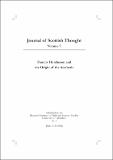Francis Hutcheson's aesthetics and his critics in Ireland: Charles-Louis de Villette and Edmund Burke
Date
2016Author
Carey, Daniel
Metadata
Show full item recordUsage
This item's downloads: 801 (view details)
Recommended Citation
D. Carey (2016) 'Francis Hutcheson s Aesthetics and his Critics in Ireland: Charles-Louis de Villette and Edmund Burke'. Journal of Scottish Thought, 7 :81-105.
Published Version
Abstract
In his own time as much as in ours, the response to Francis Hutcheson’s
philosophy has concentrated above all on his contribution to moral thought,
especially the articulation of a so-called ‘moral sense’.1 The moral sense as
described by Hutcheson responds to events in the world by notifying
the subject of pleasure when experiencing or observing acts of benevolence,
and displeasure when witnessing their opposite. Hutcheson’s
aesthetic theory has not preoccupied critics to the same extent, despite
the fact that it formed an important, indeed intrinsic part of his argument
in An Inquiry into the Original of our Ideas of Beauty and Virtue
(1725). In a vein that Shaftesbury had infl uentially explored before him,
Hutcheson began his account by establishing the model of an internal
aesthetic sense which made experience of beauty, harmony, form
and order possible. His confi dence that his audience would accept the
empirical existence of such a sense facilitated the transition to the argument
about a parallel moral sense.


